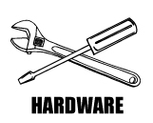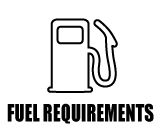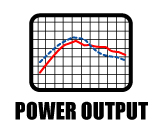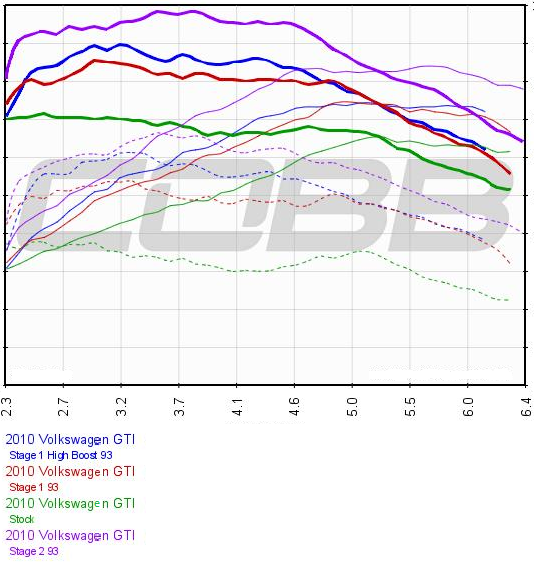Supported Vehicles:
- World Market MK6 GTI 2009-2013
- USDM MK6 GTI 2010–2014
Map Revision:
| USDM MK6 GTI | World Market MK6 GTI |
|---|---|
|
|
Map Availability:
- Download from the COBB Tuning Volkswagen GTI OTS Map Database.
Required Accessport Firmware:
COBB Custom ECU Features
Hardware Requirements: Stage1 - Otherwise stock vehicle with the following modifications*:
- Intake Requirements: Stock airbox with stock air filter or drop-in High-Flow replacement filter
- Exhaust requirements: Stock exhaust or COBB Tuning Catback Exhaust
The below High Boost calibrations are designed for vehicles that do not exhibit knock on lower power levels.
Hardware Requirements: Stage1 High Boost - Otherwise stock vehicle with the following modifications*:
- Intake Requirements: Recommended drop-in High-Flow replacement filter
- Exhaust requirements: Stock exhaust or COBB Tuning Catback Exhaust
Hardware Requirements: Stage1+ Stock MAF - Otherwise stock vehicle with the following modifications*:
- Intake Requirements: COBB Tuning SF Intake System
- Exhaust requirements: Stock exhaust or COBB Tuning Catback Exhaust
Hardware Requirements: Stage1+ - Otherwise stock vehicle with the following modifications*:
- Intake Requirements: COBB Tuning Big SF Intake System (7V1100 DISCONTINUED)
- Exhaust requirements: Stock exhaust or COBB Tuning Catback Exhaust
Hardware Requirements: Stage2 Stock MAF - Otherwise stock vehicle with the following modifications*:
Hardware Requirements: Stage2 - Otherwise stock vehicle with the following modifications*:
Map | Peak Gains* | Largest Gain* |
|---|---|---|
| Stage1 93 | +12.8% HP / +18.6% TQ | +17.1% HP / at 4900 / +22.2% TQ at 4000 |
Stage1 High boost / Stage1+ 93 | +13.2% HP / +24.7% TQ | +28.2% HP / +23.3% TQ at 4300 RPM |
Stage2 93 | +27.1% HP / +29.2% TQ | +34% HP at 4600 RPM / +35% TQ at 4000 RPM |
*Peak gains are measured as the difference between the highest points of the two plots.
*Largest gains are measured as the largest gain at any single point between the two plots.
Results may vary. Power as tested on 2010 GTI using these identical calibrations. Generally speaking, the 91 octane calibration has a richer fuel curve and a less aggressive ignition advance map to help compensate for 91 octane fuel and/or less than ideal atmospheric conditions. The map designed for 93 octane is the most aggressive.
Stage1
- Intake Requirements: Stock airbox with stock air filter or drop-in High-Flow replacement filter
- Exhaust Requirements: Stock or COBB Tuning Catback Exhaust
- Boost Target:
- 91 Octane 95 RON Minimum: ~13.5 psi peak boost pressure tapering down to 10 psi as you approach the 6800 RPM redline, +/- ~2 psi
- 93 Octane 98 RON Minimum: ~15 psi peak boost pressure tapering down to 11 psi as you approach the 6800 RPM redline, +/- ~2 psi
Stage1 High Boost
- Intake Requirements: Recommended Stock airbox with stock air filter or drop-in High-Flow replacement filter
- Exhaust Requirements: Stock or COBB Tuning Catback Exhaust
- Boost Target:
- 91 Octane 95 RON Minimum: ~16 psi peak boost pressure tapering down to 11 psi as you approach the 6800 RPM redline, +/- ~2 psi
- 93 Octane 98 RON Minimum: ~17.5 psi peak boost pressure tapering down to 11 psi as you approach the 6800 RPM redline, +/- ~2 psi
Stage1+ Stock MAF
- Intake Requirements: COBB Tuning SF Intake System
- Exhaust Requirements: Stock or COBB Tuning Catback Exhaust
- Boost Target:
- 91 Octane 95 RON Minimum: ~17 psi peak boost pressure tapering down to 11 psi as you approach the 6800 RPM redline, +/- ~2 psi
- 93 Octane 98 RON Minimum: ~18 psi peak boost pressure tapering down as you approach the 6800 RPM redline, +/- ~2 psi
Stage1+
SF Maps- Intake Requirements: COBB Tuning Big SF Intake System (7V1100 DISCONTINUED)
- Exhaust Requirements: Stock or COBB Tuning Catback Exhaust
- Boost Target:
- 91 Octane 95 RON Minimum: ~17 psi peak boost pressure tapering down to 11 psi as you approach the 6800 RPM redline, +/- ~2 psi
- 93 Octane 98 RON Minimum: ~18 psi peak boost pressure tapering down as you approach the 6800 RPM redline, +/- ~2 psi
Stage2 Stock MAF Maps
- Intake Requirements: COBB Tuning SF Intake System
- Exhaust Requirements: COBB Tuning Turboback Exhaust
- Boost Target:
- 91 Octane 95 RON Minimum: ~18.5 psi peak boost pressure tapering down to 12.5 psi as you approach the 6800 RPM redline, +/- ~2 psi
- 93 Octane 98 RON Minimum: ~19.5 psi peak boost pressure tapering down to 13 psi as you approach the 6800 RPM redline, +/- ~2 psi
Stage2 Maps
- Intake Requirements: COBB Tuning Big SF Intake System (7V1100 DISCONTINUED)
- Exhaust Requirements: COBB Tuning Turboback Exhaust
- Boost Target:
- 91 Octane 95 RON Minimum: ~18.5 psi peak boost pressure tapering down to 12.5 psi as you approach the 6800 RPM redline, +/- ~2 psi
- 93 Octane 98 RON Minimum: ~19.5 psi peak boost pressure tapering down to 13 psi as you approach the 6800 RPM redline, +/- ~2 psi
Non-Performance Maps
Anti-Theft Mode
- Will not allow vehicle to start
Valet
- Fuel Requirements:
- 91 octane or better
- Intake Requirements: Stock airbox and stock air filter
- Exhaust Requirements: Stock exhaust
- Boost Targets: Mechanical minimum
- Rev Limiter: 3000 RPM
*Not intended for aggressive driving*
All Stage1 performance maps include a "High boost" version:
- High boost: Higher Load request for use when normal calibration produces no knock and the user desires slightly higher power level.
High Altitude:
A quick note for those of you that live at higher altitudes: it is common for turbocharged cars at higher altitudes to run less boost pressure due to lower air pressure and air density. Your turbocharger has to work harder to compress a less dense air mass compared to the same turbocharger at sea level. This must be factored in when determining if your turbocharger is running the proper amount of boost pressure and not being pushed beyond its efficiency range.
Example: If you live in Denver at 5280 ft. and are trying to run a peak boost pressure of 15 psi, your turbocharger has to work the equivalent of making ~17.5 psi at sea level.
There are barometric compensations within the factory ECU that lower boost targets as you climb in altitude in an effort to keep the turbocharger in its optimal range. The COBB performance maps utilize these compensations and therefore, it is perfectly normal for the final boost / load value to be lower than what is listed for your map.
Revision Notes:
v107
- No calibration changes.
- Maps have been updated to eliminate unnecessary DTC suppression.
v106
- No calibration changes.
- Version parity update across all USDM MK6 GTI Maps.
- Critical Bug Fix: Applies to USDM Volkswagen GTI CCTA 1K0907115AP - Fixed v105 map issue causing ECUs to brick after a reflash.
- Warning: Please discard any existing v105 maps for USDM Volkswagen GTI (CCTA 115AP).
v105
- No calibration changes.
- Version parity update across all USDM MK6 GTI Maps.
- USDM Volkswagen GTI CCTA 1K0907115AP - Fixed issue preventing v104 maps from allowing Accessport to install.
- USDM Volkswagen GTI CBFA 1K0907115AL - Fixed listed octane value description value for Stage2 Stock MAF 93. Showed 91 instead of 93 OCT.
v104
- Removed model year from vehicle application name.
- Enabled COBB Custom Features for USDM vehicles which include flat foot shift and launch control.
v103
- Changed MAF compensation logic to use the newly exposed MAF Scaling Table for COBB Big SF intake system.
- Updated fueling logic for more consistent fueling.
v102
- Addressed text display bug in long map description
- Corrected DTC enable/disable logic for AL,AM,AP,AQ and AT ROM's. (AS was unaffected)
- Added Big SF to long description in appropriate calibrations (Stage1+ and Stage2)
- Corrected logic for torque reduction request on 115AS ROM
- Updated revision box to match short description
v101
- Revised part throttle torque requests for performance and drivability
v100
- Revised ignition timing, primary fueling and boost levels for performance and safety




